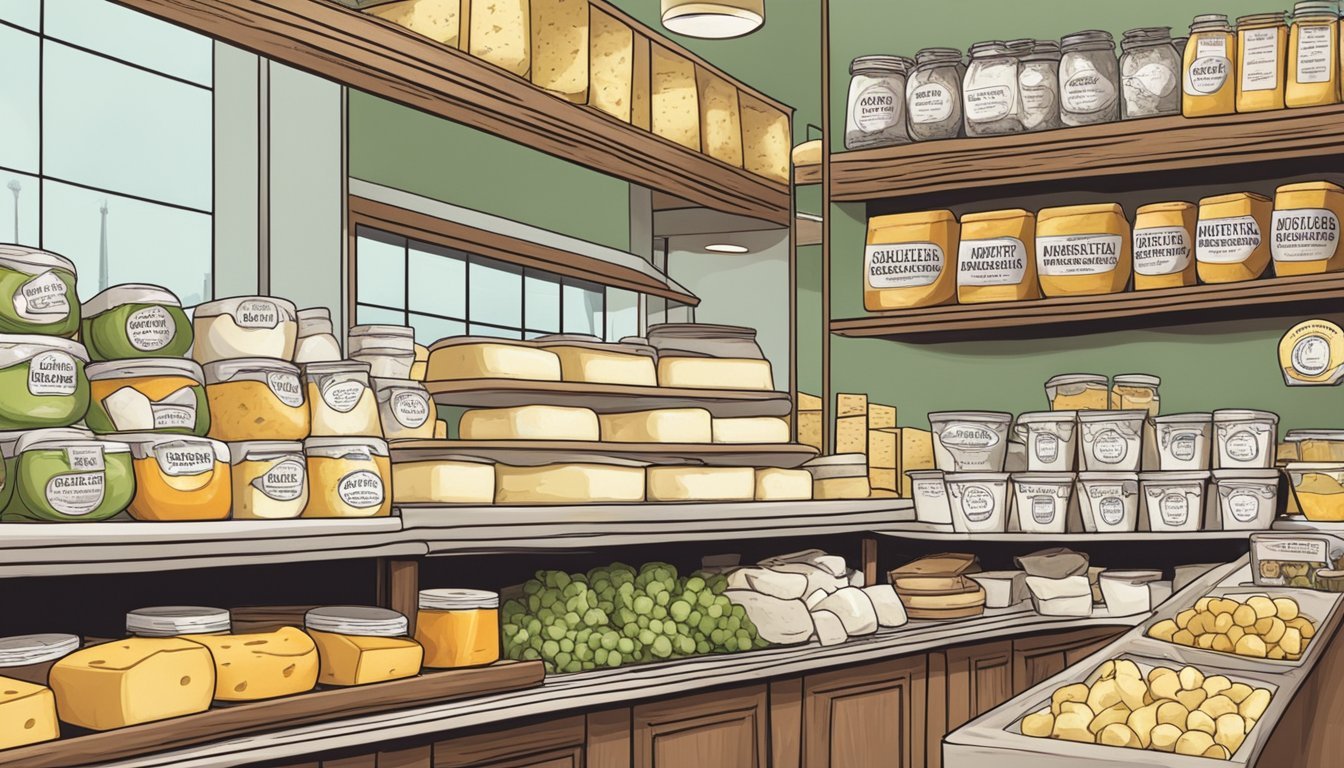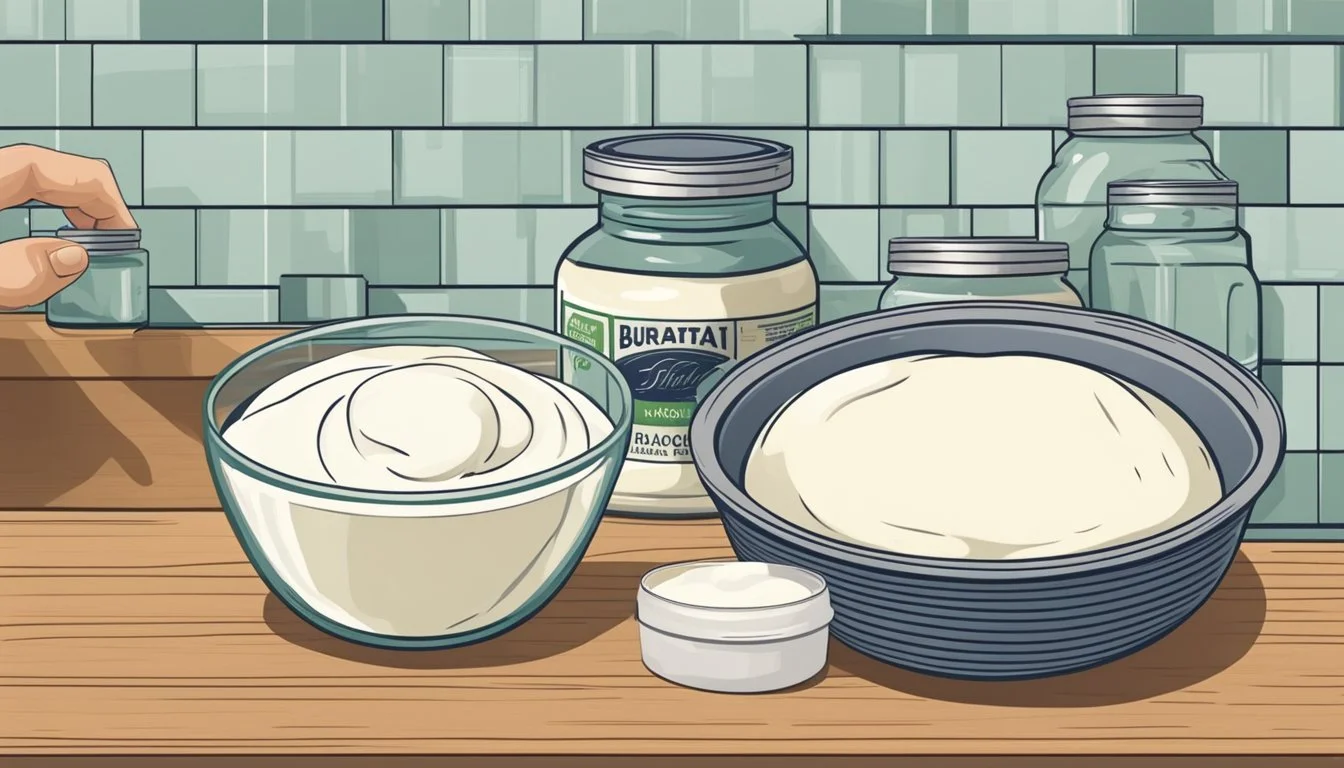Burrata Substitutes
Find the Perfect Alternative for Your Recipes
Burrata cheese, known for its creamy texture and luscious interior, is a staple in many Italian dishes. Yet, finding a substitute that mimics its rich qualities can be a challenge. Some excellent alternatives to burrata include mascarpone, mozzarella, and ricotta, which can provide a creamy texture and mild flavor similar to this beloved cheese.
For those looking to experiment, cashew cheese and almond cheese offer dairy-free options that still deliver smooth and rich texture. Each substitute brings its own unique characteristics, allowing for creativity in the kitchen while still capturing the essence of what makes burrata so special.
Choosing the right substitute depends on the specific dish and desired flavor profile. Queso fresco, feta, and brie can also work in different culinary contexts, providing versatility while maintaining a balance in taste and texture.
Understanding Burrata Cheese
Burrata is a type of Italian cheese known for its unique, creamy texture. Originating from the Apulia region, this cheese is made from buffalo milk or cow's milk.
The outer shell of burrata resembles fresh mozzarella, but the inside is filled with a soft mixture called stracciatella and cream. This combination gives burrata its signature velvety and delicate flavor.
Burrata vs Mozzarella:
Burrata: Soft, creamy interior, made from buffalo or cow's milk.
Mozzarella: Firm, stretchy texture, typically made from buffalo milk or cow's milk.
In Italian cuisine, burrata is often served fresh, highlighting its rich and creamy qualities. It pairs well with salads, fresh tomatoes, and crusty bread.
Nutritional Information:
Rich in protein and calcium
Contains cream for added smoothness
Higher fat content due to the creamy center
Burrata must be consumed fresh to fully enjoy its texture and flavor. It is often used in simple dishes to let its characteristics shine through.
Dairy-Based Substitutes for Burrata
When looking for substitutes for burrata, various dairy-based alternatives offer similar textures and flavors. Each option brings its unique characteristics, making it suitable for different culinary uses. Here are some specific substitutes to consider.
Mozzarella Cheese
Mozzarella is perhaps the closest substitute for burrata. Both share a semi-soft texture and mild flavor profile. Mozzarella is well-known for its creamy interior, especially when fresh. Unlike burrata, it lacks the rich cream filling but still delivers a buttery mouthfeel. Ideal for salads, pizzas, and caprese dishes, mozzarella is versatile and widely available. Fresh mozzarella provides the best substitution experience due to its moisture content and delicate taste.
Ricotta Cheese
Ricotta cheese offers a creamy texture and slightly sweet flavor, making it a suitable stand-in for burrata. It's made from the whey leftover after making other cheeses, contributing to its rich yet light consistency. Ricotta pairs well with both sweet and savory dishes. While it lacks burrata's chewy outer layer, its smooth interior mimics the creamy filling found in burrata. Use it in lasagnas, stuffed pastas, or as a spread on crostini.
Mascarpone Cheese
Mascarpone is a rich and creamy cheese known for its role in desserts like tiramisu. When substituting burrata, mascarpone's smooth texture and mild, slightly sweet flavor make it an excellent choice. It lacks any chewy exterior but compensates with its luxurious creaminess. This cheese is best used in dishes where burrata's creamy interior is the highlight, such as in spreads or paired with fruits.
Feta Cheese
Feta cheese, with its tangy flavor and crumbly texture, is a distinct alternative to burrata. Typically made from sheep or goat milk, feta provides a sharp contrast to burrata's mildness. Though not as creamy, its bold flavor can enhance salads, pizzas, and Mediterranean dishes. Crumbled feta can work well when a punch of flavor is desired, offering a different yet delightful experience.
Cream Cheese
Cream cheese is another potential substitute, offering a smooth and rich texture. Commonly used in spreads and desserts, it has a mild taste that can adapt to various dishes. Cream cheese doesn't have burrata's stretchy outer layer but shares its creamy consistency. Use it in bagels, dips, or as a base for sauces. For a closer match, blend with a bit of milk or cream to achieve a softer texture.
Stracciatella Cheese
Stracciatella, often considered the heart of burrata, shares the same creamy and stringy texture. Made from pulling and shredding fresh mozzarella curds, it is mixed with cream to create a luxurious cheese. Stracciatella is perfect for drizzling over pasta, topping pizzas, or serving with fresh tomatoes and basil. It mirrors burrata’s characteristics almost exactly, making it one of the best substitutes available.
Brie Cheese
Brie, a soft cheese known for its creamy interior and edible rind, can serve as a burrata substitute. While it has a distinct flavor profile with a slight tangy taste, its rich texture mirrors burrata's creaminess. Brie can be baked or used in salads, sandwiches, or as a standalone appetizer. Choose a triple-cream brie for an even richer, more buttery experience.
Cottage Cheese
Cottage cheese provides a lower-fat alternative with a slightly chunky texture. Its mild flavor makes it versatile, but it doesn't offer the same creamy consistency as burrata. Mixed with a bit of cream, cottage cheese can better replicate burrata's texture. This cheese works well in salads, dips, and baked dishes. It's an accessible choice for those looking for a healthier option without compromising too much on richness.
Queso Fresco
Queso Fresco, a fresh Mexican cheese, offers a light and crumbly texture similar to feta. It has a mild, slightly tangy flavor that can complement various dishes. Though not as creamy as burrata, Queso Fresco can be used in salads, tacos, and enchiladas. When looking for a lighter burrata substitute, this cheese provides a refreshing alternative with its fresh, milky taste.
Vegan and Non-Dairy Alternatives
For those following a vegan or dairy-free diet, there are several excellent substitutes for burrata. These alternatives can offer flavors ranging from creamy and rich to neutral and nutty, suitable for various culinary applications.
Cashew Cheese
Cashew cheese is a popular vegan option as it delivers a creamy flavor and smooth texture similar to burrata. Made from soaked, blended cashews, it’s often enhanced with nutritional yeast for added savory notes. It pairs well with salads, pizzas, and even spreads for sandwiches. Cashew cheese can be flavored with herbs and spices to suit various dishes, making it versatile and highly customizable.
Almond Cheese
Almond cheese offers a firm yet creamy texture, and it's another great dairy-free choice. This type of cheese is made from blanched almonds and water, then blended smooth. The result is a nutty, slightly sweet taste that can be seasoned according to preference. Almond cheese is perfect for those looking for a burrata substitute that combines both creamy and nutty flavors in one.
Tofu
Tofu stands out as a neutral flavor option that easily absorbs other tastes from a dish. It's an adaptable ingredient for those avoiding dairy. To mimic the texture of burrata, soft or silken tofu can be blended until smooth and creamy. It's suitable for various preparations, including salads and pasta dishes, where it acts as a vessel for other flavors.
Nutritional Yeast
Nutritional yeast is not a cheese but plays a significant role in vegan cheese recipes. It imparts a cheesy, savory taste and is often used to boost the flavor profile of nut-based cheeses like cashew or almond cheese. Rich in B vitamins, it adds depth without the need for dairy, making it an excellent ingredient for enhancing vegan alternatives.
Usage in Cooking and Recipes
Various burrata substitutes can seamlessly integrate into diverse dishes, offering a range of textures and flavors that cater to different culinary needs. These alternatives can be creatively utilized in salads, pasta dishes, pizzas, stuffed meals, and as spreads and dips.
Salad Applications
Cheeses like mozzarella and ricotta can be excellent substitutes for burrata in salads. Caprese salad benefits greatly from mozzarella's milky taste and texture. Mozzarella pairs well with tomatoes, basil, and olive oil, maintaining a refreshing balance.
For a creamier alternative, ricotta or mascarpone can be mixed with roasted vegetables and sprinkled with olive oil. Vegan cheeses like almond or cashew cheese offer a healthy twist, ideal for those avoiding dairy.
Pasta Dishes
Burrata substitutes work well in various pasta dishes, often enhancing the creamy flavor. Ricotta is a frequent choice in lasagna and ravioli due to its rich texture.
Mascarpone can add a slight sweetness and creaminess to pasta sauces, transforming simple pasta dishes into gourmet experiences. Those aiming for a vegan option may prefer tofu, which adapts well to the flavors used in pasta dishes.
Pizza Toppings
When used on pizzas, burrata substitutes like mozzarella and brie provide a delightful, creamy texture. Mozzarella cheese's stretchy, salty flavor makes it a classic pizza topping, matching well with tomatoes and basil.
Brie introduces a slightly earthier taste, suitable for gourmet pizza recipes with roasted vegetables or prosciutto. Almond and cashew cheeses offer a vegan alternative that melts beautifully, enhancing the pizza's taste and texture.
Stuffed and Cooked Dishes
Burrata's substitutes can be effectively used in stuffed and cooked dishes such as enchiladas and stuffed peppers. Ricotta cheese is commonly utilized in these recipes due to its soft texture and ability to blend well with various ingredients.
In dishes like ravioli and lasagna, mascarpone cheese can add a subtle sweetness and creamy layer. Vegan options such as almond or tofu-based cheeses can provide the required milky taste without compromising on the dish's integrity.
Spreads and Dips
When it comes to spreads and dips, mascarpone or ricotta can be used to achieve a creamy consistency suitable for various accompaniments. Ricotta mixed with olive oil, herbs, and a bit of salt can create a delicious dip.
For a touch of sweetness, mascarpone can be blended with honey and used as a spread for crackers. Vegan cheeses like almond cheese offer a dairy-free alternative that remains rich and spreadable, perfect for savory or sweet applications.
Selecting the Right Substitute
When choosing a substitute for burrata cheese, it is crucial to consider the flavor, texture, and nutritional aspects to find the best match for your recipe. Various options, both dairy-based and plant-based, can offer creamy, smooth, or tangy profiles.
Flavor Considerations
Flavor is a significant factor. Burrata has a mild, creamy taste with a slight tang. Alternatives like mozzarella and feta cheese can serve well, though they differ in intensity.
Feta provides a saltier and tangier profile, while mozzarella is closer in mildness. Cream cheese and ricotta are also suitable; they both bring creaminess but differ in texture. Plant-based options like cashew cheese or almond cheese offer a nutty flavor, which might alter the intended taste of the dish.
Texture Matching
Texture is equally important. Burrata features a soft, creamy interior surrounded by a firm outer shell. Mozzarella replicates this soft yet firm structure, making it a top choice.
Ricotta and cream cheese are uniformly creamy and may do well in recipes where a smooth texture is paramount. Queso fresco and cotija cheese are similar but crumble more, providing less of the burrata’s smooth bite.
For plant-based diets, tofu or almond cheese can mimic the creamy texture, though they won't entirely match burrata's bloomy rind feel.
Nutritional Aspects
Nutritional content varies significantly among substitutes. Dairy-based options like feta, mozzarella, and cream cheese are rich in calcium and protein but may contain more calories and fats.
Plant-based alternatives like cashew or almond cheese are lower in cholesterol and can be good for lactose-intolerant individuals. However, they might lack the same high levels of calcium.
When considering nutritional substitutes, balance the dietary needs with the textural and flavor profiles to maintain the integrity of the dish while accommodating health preferences. Each substitute's unique nutritional profile may either enhance or limit its suitability.
Purchase and Storage Tips
When purchasing burrata from grocery stores, it's important to consider its freshness. Look for cheese that is stored in its whey or brine solution, as this ensures it remains moist and soft.
Italian cheese like burrata is often found in the specialty cheese section. Examine the packaging date and opt for the freshest batch available. In the United States, many stores carry burrata in both regular and gourmet grocery stores.
Shelf life of burrata is relatively short. This cheese should ideally be consumed within 48 hours of purchase for optimal flavor and texture. Keeping it for longer might cause it to lose its creamy interior and become less enjoyable.
Refrigeration is crucial for burrata. Store it in its original packaging and place it in the coldest part of the refrigerator. If you've opened the packaging, ensure the cheese is submerged in its brine water to maintain its freshness and creamy consistency.
To maintain freshness, always keep burrata at a temperature between 35°F and 40°F. If traveling with burrata, use a cooler with ice packs to keep it cool until you can refrigerate it again.
When serving burrata, take it out of the refrigerator about 30 minutes before to let it come to room temperature. This enhances its creamy texture and flavor. Always use clean utensils to avoid contamination.
For further storage, use an airtight container if the original packaging is compromised. Remember, while freezing is an option, it can drastically alter the texture, making it less desirable for most recipes.
Incorporating Substitutes in Traditional Italian Cuisine
Choosing the right substitutes for burrata can enhance traditional Italian dishes without compromising authenticity or flavor. This section explores how to use alternatives effectively in various regional and modern Italian recipes.
Authentic Experience with Substitutes
In Italian cuisine, mozzarella and bocconcini cheese offer creamy textures similar to burrata. When buffalo milk is used, these substitutes can provide a near-authentic taste. For instance, mozzarella di bufala can be a delightful addition to a Caprese salad, paired with tomatoes, basil, and a drizzle of olive oil.
Feta cheese and cream cheese can also be used but may alter the dish's flavor profile. Incorporating feta in bruschetta or pasta dishes can add a tangy note, while cream cheese works best in spreads or with prosciutto for a smoother texture.
Regional Dishes of Puglia
Puglia, the birthplace of burrata, features dishes where traditional and substitute cheeses can shine. Bocconcini or cow milk mozzarella can replace burrata in dishes like orecchiette pasta with broccoli rabe, ensuring a consistent creamy texture.
For the classic stracciatella, combining cream cheese with fresh mozzarella can mimic burrata's creamy center. This blend complements dishes like focaccia di Puglia or pizza toppings, maintaining the indulgent essence of original recipes.
Fusion and Modern Twists
Modern Italian cuisine often blends traditional elements with innovative flavors. Cheese melts like queso fresco or cashew cheese (vegan option) can serve as burrata substitutes in fusion dishes. Queso fresco lends a mild flavor perfect for combining with herbs and spices in pasta dishes or as a pizza topping.
Cashew cheese, with its nutty taste, can revolutionize vegan Italian dishes, adding creaminess to vegan lasagna or risotto. Using these alternatives enables chefs to keep Italian cuisine accessible and inclusive, catering to various dietary preferences without losing the essence of traditional dishes.








